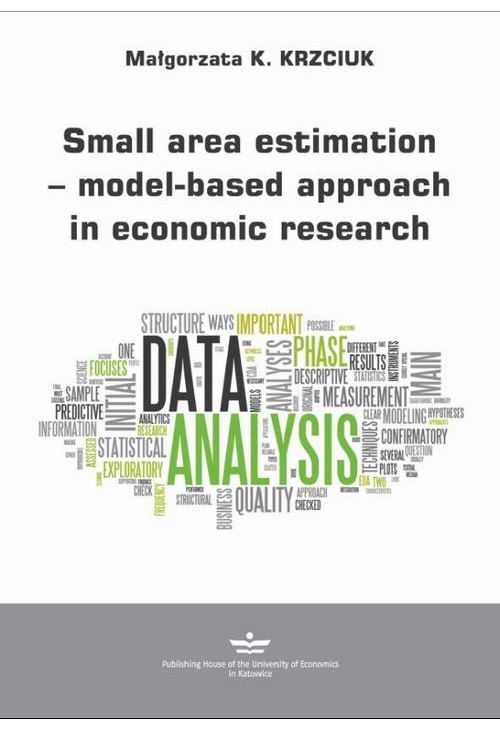
- Za darmo
ebook Small area estimation ‒ model-based approach in economic research
Odkryj fascynujący świat "Small area estimation ‒ model-based approach in economic research" autorstwa Małgorzaty K. Krzciuk, wydanej przez Wydawnictwo Uniwersytetu Ekonomicznego w Katowicach w 2023 roku. Ta wyjątkowa publikacja skupia się na metodach prognozowania cech podpopulacji oraz analizie właściwości przewidywań, uwzględniając korelację między zmiennymi losowymi.
W tej cennej e-książce znajdziesz praktyczne zastosowania małych obszarów szacunkowych - podejścia modelowego dla danych ekonomicznych pozyskanych w badaniach podłużnych. Autorka wprowadza innowacyjne modele nadpopulacji należące do klasy ogólnych liniowych modeli mieszanych oraz proponuje autorskie metody weryfikacji modeli.
Zgłębiając treść ebooka, poznasz również oryginalne techniki predykcji i oceny dokładności przewidywania cech podpopulacji dla proponowanej klasy modeli. Publikacja zawiera także studia symulacyjne przeprowadzone z wykorzystaniem metody Monte Carlo, co demonstruje praktyczną przydatność przedstawionych rozwiązań w analizie danych ekonomicznych.
Nie czekaj - pobierz swoją kopię ebooka "Small area estimation ‒ model-based approach in economic research" już teraz i zanurz się w świecie precyzyjnego prognozowania!
Spis treści ebooka Small area estimation ‒ model-based approach in economic research
Introduction 5Chapter 1. Theoretical foundations of small area estimation
1.1. Main approaches in small area estimation – basic definitions and notation 8
1.1.1. Design-based approach 10
1.1.2. Model-based approach 16
1.1.3. Model-assisted approach 21
1.2. Superpopulation model and the steps of its construction 26
1.2.1. Mixed models 26
1.2.2. Special cases of linear mixed models with uncorrelated random effects 32
1.2.3. Special cases of linear mixed models with correlated random effects 36
1.2.4. Steps of model construction 39
1.3. Development of small area estimation 48
1.4. Applications of small area estimation 51
1.5. Summary 54
Chapter 2. Cross-sectional and longitudinal economic surveys
2.1. Research conducted during one period 56
2.2. Essence of longitudinal surveys 58
2.3. Types of longitudinal surveys 59
2.3.1. Panel studies 59
2.3.2. Repeated time surveys with partial rotation 65
2.3.3. Multi-period surveys with complete rotation 67
2.4. Advantages and disadvantages of longitudinal surveys 69
2.4.1. Advantages of time-repeated surveys 70
2.4.2. Disadvantages and limitations of longitudinal surveys 72
2.5. Summary 75
Chapter 3. Empirical best linear unbiased predictors
3.1. Empirical best linear unbiased predictors of Royall and Henderson 77
3.1.1. BLU predictor of Royall 78
3.1.2. Henderson’s best linear unbiased predictor 80
3.2. Empirical best linear unbiased predictor and classification of linear mixed models 82
3.2.1. EBLUP for type A models 82
3.2.2. EBLUP for type B models 83
3.3. EBLUP and the class of linear mixed models with correlated random effects 84
3.4. Mean squared prediction error and its estimator 85
3.5. Selected EBLUP modifications and their applications 87
3.5.1. SEBLUP 88
3.5.2. REBLUP 90
3.5.3. SREBLUP 92
3.5.4. GWEBLUP and RGWEBLUP 93
3.5.5. Pseudo-EBLUP 96
3.5.6. NPEBLUP 99
3.6. EBLUP applications 100
3.7. Summary 102
Chapter 4. Empirical best predictors and plug-in predictors
4.1. Empirical best predictor 104
4.2. Plug-in predictor 105
4.3. EBP and plug-in predictors, and linear mixed models with correlated random effects vectors 107
4.4. Estimation of the mean squared error of EBP and plug-in predictors 108
4.5. Applications of EB and plug-in predictors 109
4.6. Summary 111
Chapter 5. Simulation studies
5.1. Dataset 113
5.2. Simulation study – variant I 116
5.3. Simulation study – variant II 126
5.4. Simulation study – variant III 134
5.5. Summary 142
Conclusions 145
Bibliography 148
List of figures 175
List of tables 177
Szczegóły ebooka Small area estimation ‒ model-based approach in economic research
- Wydawca:
- Wydawnictwo Uniwersytetu Ekonomicznego w Katowicach
- Rok wydania:
- 2023
- Typ publikacji:
- Ebook
- Język:
- angielski
- Format:
- Liczba stron:
- 178
- Miejsce wydania:
- Katowice
Recenzje ebooka Small area estimation ‒ model-based approach in economic research
-
Reviews (0)

Na jakich urządzeniach mogę czytać ebooki?
- Za darmo















@CUSTOMER_NAME@
@COMMENT_TITLE@
@COMMENT_COMMENT@